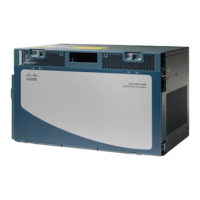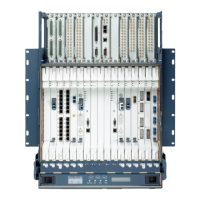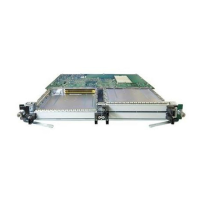2-95
Cisco ONS 15454 Troubleshooting Guide, R8.5
November 2009
Chapter 2 Alarm Troubleshooting
2.7.103 FAILTOSW-PATH
SONET Logical Objects: EQPT, OCN
DWDM Logical Objects: 2R, ESCON, FC, GE, ISC, TRUNK
The Failure to Switch to Protection Facility condition occurs when a working or protect electrical or
optical facility switches to its companion port by using a MANUAL command. For example, if you
attempt to manually switch traffic from an unused protect port to an in-service working port, the switch
will fail (because traffic is already present on the working port) and you will see the FAILTOSW
condition.
Clear the FAILTOSW Condition
Step 1 Look up and troubleshoot the higher-priority alarm. Clearing the higher-priority condition frees the card
and clears the FAILTOSW.
Note A higher-priority alarm is an alarm raised on the working DS-N card using the 1:N card
protection group. The working DS-N card is reporting an alarm but not reporting a FAILTOSW
condition.
Step 2 If the condition does not clear, replace the working electrical or optical card that is reporting the
higher-priority alarm by following the “Physically Replace a Traffic Card” procedure on page 2-273.
This card is the working electrical or optical card using the protect card and not reporting FAILTOSW.
Replacing the working electrical or optical card that is reporting the higher-priority alarm allows traffic
to revert to the working slot and the card reporting the FAILTOSW to switch to the protect card.
Step 3 If the condition does not clear, log into the Technical Support Website at
http://www.cisco.com/techsupport for more information or call Cisco TAC 1 800 553-2447.
2.7.103 FAILTOSW-PATH
Default Severity: Not Alarmed (NA), Non-Service-Affecting (NSA)
SONET Logical Objects: STSMON, VT-MON
The Fail to Switch to Protection Path condition occurs when the working circuit does not switch to the
protection circuit on a path protection configuration. Common causes of the FAILTOSW-PATH alarm
include a missing or defective protect port, a lockout set on one of the path protection nodes, or
path-level alarms that would cause a path protection switch to fail including the “AIS-P” condition on
page 2-37, the “LOP-P” alarm on page 2-155, the “SD-P” condition on page 2-220, the “SF-P” condition
on page 2-224, and the “UNEQ-P” alarm on page 2-252.
The “LOF (OCN)” alarm on page 2-151, the “LOS (OCN)” alarm on page 2-164, the “SD-L” condition
on page 2-220, or the “SF-L” condition on page 2-223 can also occur on the failed path.
Clear the FAILTOSW-PATH Condition in a Path Protection Configuration
Step 1 Look up and clear the higher-priority alarm. Clearing this alarm frees the standby card and clears the
FAILTOSW-PATH condition. If the “AIS-P” condition on page 2-37, the “LOP-P” alarm on page 2-155,
the “UNEQ-P” alarm on page 2-252, the “SF-P” condition on page 2-224, the “SD-P” condition on

